The HTC One X for AT&T Review
by Brian Klug on May 1, 2012 6:00 PM EST- Posted in
- Smartphones
- Snapdragon
- HTC
- Qualcomm
- MSM8960
- Krait
- Mobile
- Tegra 3
- HTC One
- NVIDIA
Javascript Performance
Although smartphones are clearly headed for a life beyond simple messaging, web browsing and phone duties, we are still lacking the tools to measure performance in areas other than a component of web page rendering. Measuring javascript performance is one component of the entire web page rendering process but it's the most mature in terms of something we can benchmark.
Sunspider is quite possibly the most well known of these javascript tests:
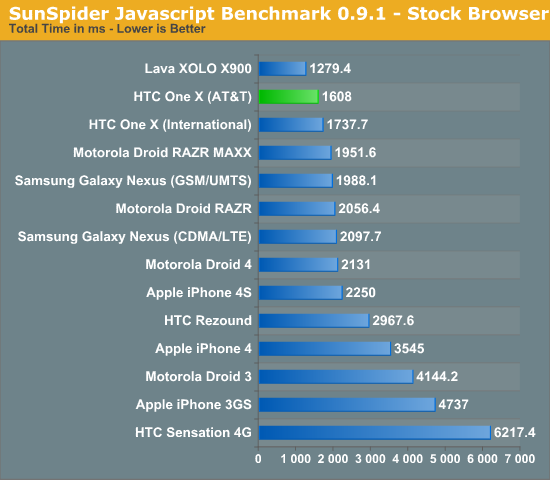
We expected Snapdragon S4 to do very well here based on our preview numbers and it did not disappoint. Although it's not quite as fast as Intel's Medfield, it's clearly the fastest smartphone SoC in this test otherwise. It's worth noting that HTC is able to deliver performance that's within 5% of Qualcomm's Snapdragon S4 MDP, a significant improvement over where things were last year.
The Sunspider test makes good use of 1 - 2 cores but there are times when it'll stress all four on a Tegra 3. For the most part however, NVIDIA's extra cores go unused in this benchmark. Krait and HTC's ICS browser definitely offer a significant advantage over the performance of the ICS launch vehicle, Samsung's Galaxy Nexus. This is honestly the hardware that Google should have used as the basis for its Nexus platform, it's too bad that it wasn't available at the end of last year.
BrowserMark is another js benchmark in our suite:
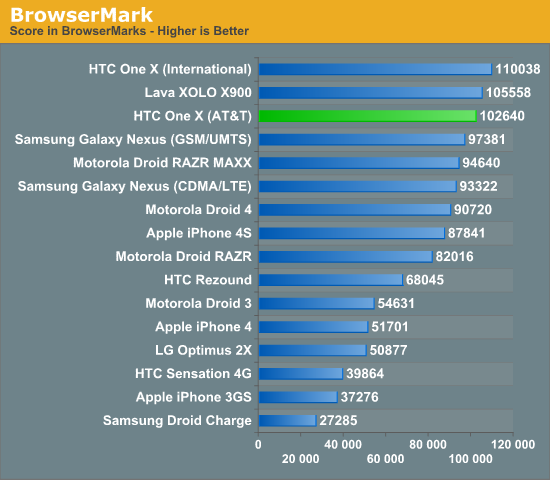
Here the international and AT&T One Xes trade spots as Tegra 3's extra cores are able to give it the slight edge in performance. Once again we're talking about the fastest smartphones in our test suite.
Low Level FP Performance
Linpack isn't a great indication of smartphone performance, but it is a good test of the floating point capabilities of the CPUs in these SoCs. ARM has steadily been improving FP performance for the past few generations but we're going to see a big jump to Krait/A15. As most client smartphone workloads are integer based and those that are FP heavy end up relying on the GPU, an advantage here doesn't tell us much today (particularly because Linpack isn't running native code but rather atop Dalvik) other than how speedy the FPUs are:
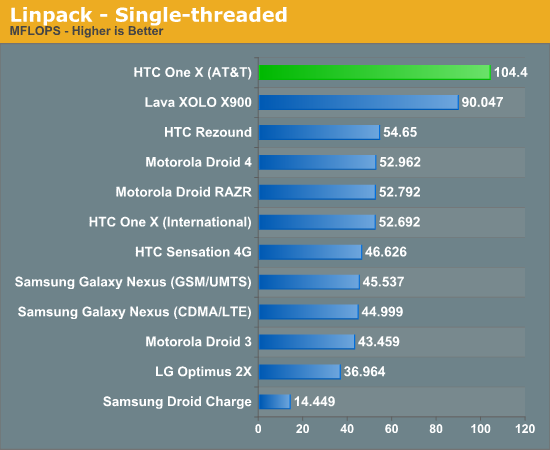
Improved single threaded FP and memory performance is something we get with Krait, and it's demonstrated quite well by the AT&T One X. While you're unlikely to see this magnitude of an advantage in most real world smartphone workloads, this is an architectural advantage of Qualcomm's Krait that's worth mentioning. However these days most FP intensive workloads on smartphones are handled by the GPU, making this performance advantage mostly academic at this point.
Linpack, like many scientific workloads, scales up to multiple cores quite nicely. If we spawn as many threads as there are logical cores (2 for Intel and Qualcomm, but 4 for NVIDIA's Tegra 3) we can see how these SoCs fare in a multithreaded world:

BaseMark OS
Rightware's BaseMark OS is a general purpose benchmark designed to better simulate overall Android performance. It includes a heavily threaded benchmark, file IO tests, and compression/decompression tasks that all contribute to its overall score. We only have results from the HTC One S/AT&T One X (Snapdragon S4), One X (Tegra 3), Galaxy Nexus (OMAP 4) and the Lava phone (Medfield) here:
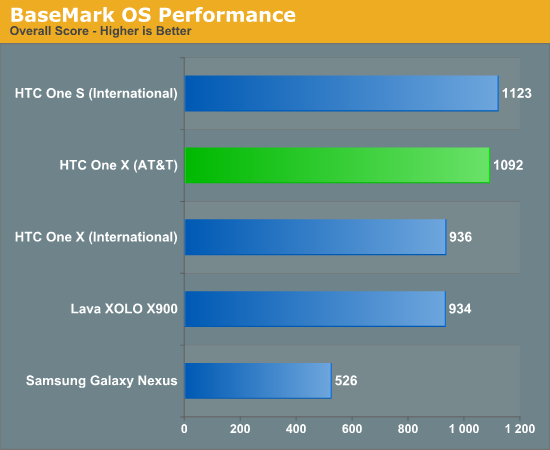
As expected, the AT&T One X does very well in this general purpose, OS-level benchmark. The device significantly outperforms Samsung's Galaxy Nexus, which isn't a surprise given how dated the hardware was at the time of launch. Again the magnitude of advantage is likely exaggerated by this benchmark, but there's no changing the fact that HTC makes the fastest Android smartphones on the planet for now.
Note that the performance difference between the two One X models is likely exaggerated by BaseMark OS as well. In our regular use we found the two to be fairly similar in performance, with the slight edge going to the AT&T One X but not by a huge margin. You'd be hard pressed to tell these two apart.
Vellamo
Vellamo is a Qualcomm developed benchmark that focuses primarily on browser performance, both in rendering and UI speed. The results are heavily influenced by the browser used on the device being tested. As a whole Vellamo isn't always indicative of whether or not you're going to get a smooth browsing experience, but it's another datapoint that captures more than just javascript performance. The Qualcomm-developed nature of the benchmark is always cause for concern, but even if you exclude the Snapdragon results the benchmark can be useful:

Qualcomm's SoCs have always done very well in this Qualcomm-built benchmark, but the results still echo what we've seen in practice. The AT&T One X definitely feels like the fastest Android phone we've used, especially compared to much of what was available last year. The gap between the international and AT&T One X versions is, once again, debatable. The Qualcomm performance advantage is at times perceivable, but I wouldn't consider it to be significant at all.
Flash Rendering Performance
These days nearly all high-end smartphones (I refuse to call them superphones) can render Flash smoothly. The HTC One X is no exception. We're basically at vsync here and will have to move to either more stressful flash content to test or just accept that flash is already performant enough.

GPU Performance - GLBenchmark 2.1
As we wait for actual 3D gaming benchmarks to make their way into Android (and hopefully crossplatform) games, we must rely on synthetic tests designed to simulate 3D game performance as best as possible. We start with GLBenchmark, one of the better Android GPU tests on the market today. There are two benchmarks, Egypt and Pro, and each is run in two modes: native screen resolution and offscreen (vsync disabled) at 720p. The latter is more useful for apples to apples comparisons as everything is rendering the same number of pixels, whereas performance in the onscreen tests is determined by the screen resolution of the device along with the performance of its GPU.
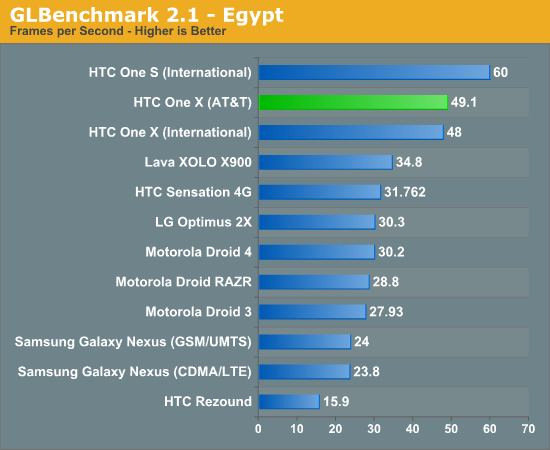
Part of the deal in getting Krait to market as quickly as possible required that Qualcomm pair the CPU with an older GPU, in this case the Adreno 225 instead of the newer Adreno 3xx offerings due out later this year. As a result, the AT&T One X can take a back seat to the international One X in GPU performance. When not limited by v-sync, the Tegra 3 based international One X is about 12% faster than the Qualcomm S4 based AT&T One X. For most gaming however, you'll be hard pressed to notice a performance difference.
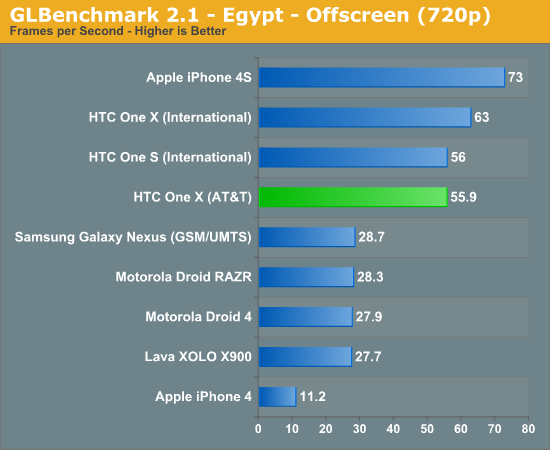
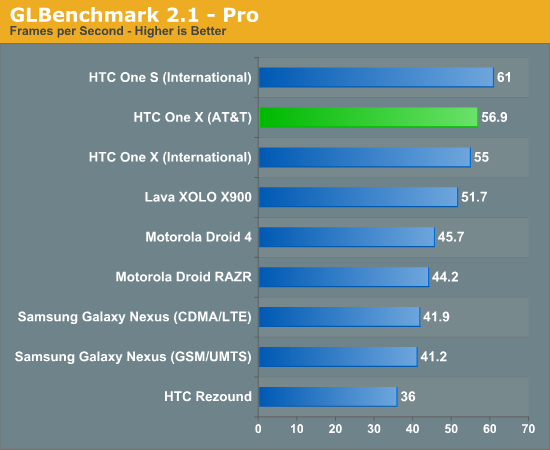
The Pro offscreen results actually flip flop a bit with the AT&T One X leading the international version. Once again, limited by v-sync (onscreen results) the two are basically identical performers.
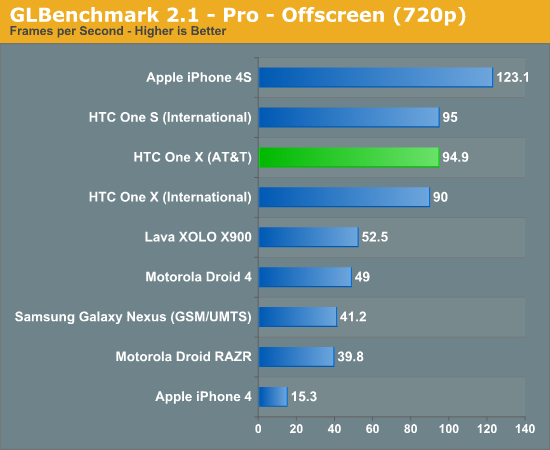
Basemark ES 2.0 V1
Rightware's Basemark ES 2.0 V1 is an aging GPU test that tends to favor Qualcomm's Adreno GPUs above almost all others:

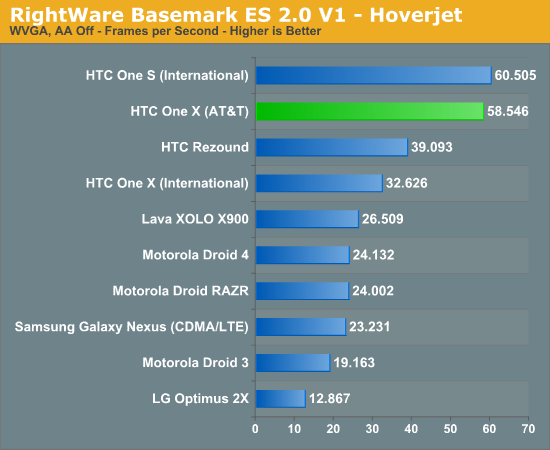
We're not surprised to see the AT&T One X do so well here as it appears Qualcomm has done quite a bit of optimization work for this particular benchmark. I wouldn't put too much faith in these numbers other than to show you an example of just what can happen with a good amount of optimization on behalf of a hardware vendor.










137 Comments
View All Comments
Stormkroe - Wednesday, May 2, 2012 - link
The confusion comes from the fact that doubling power to a speaker gains you roughly 3 dB, so a speaker at 600 watts is only around 3 dB louder than the same speaker at 300 watts. Those darned sine waves :)ssddaydream - Saturday, May 5, 2012 - link
True, but the brain tends to perceive 10dB as twice as loud, even though it is 10X the power.I agree that any graphs should be on the dB scale, so that it is easier to judge differences.
EarthsDM - Wednesday, May 2, 2012 - link
Hi Brian, thanks for the review. What pages do you use for the mobile battery life test? Are they mobile formatted? Do they have Flash?Peanutsrevenge - Wednesday, May 2, 2012 - link
If it wasn't for the lack of removable battery/storage, I would be all over this like a fanboy to Apple, but I would much prefer even a 5mm thicker phone to have those options.I need to change batteries roughly once a week around 2-3pm and I'm not sure the added battery life over my Sensation would always see me through.
The removable storage... I just prefer to have it even though I only occasionally use it.
Nice review as always though chappies!
dcollins - Wednesday, May 2, 2012 - link
I want this phone so badly. Would an unlocked version work on Verizon's network?Impulses - Wednesday, May 2, 2012 - link
Absolutely not.ssddaydream - Saturday, May 5, 2012 - link
?It should be possible with proper hacking. The Rezound can essentially be modified into a world phone, since it has GSM hardware.
The One X does have the required basebands. It will likely not work at all on T-mobile though.
Never say never, it is technically possible. I suspect the probability isn't too high, but where would we be today if everybody thought everything was impossible?
icrf - Wednesday, May 2, 2012 - link
"high-end smartphones (I refuse to call them superphones)"thank you
georgekn3mp - Wednesday, May 2, 2012 - link
Im still loving my HTC Rezound 6 months later...and wondering why they backpedaled in some ways.Rezound has 16GB internal and 16 GB secondary SD and can expand to 80GB with a 64GB card...
Rezound has true LCD 1280x720, vs. One X SAMOLED...guess that one could be a toss-up to user preferences as both screens are rated top in reviews...especially compared to Pentiles. So it didnt oversaturate colors..thats a good thing.
Rezound has removable battery and can be upgraded to 2750 extended battery or higher.
Of course I'd love to know why Anand never published a Rezound review when I know they had said they had one!
The camera on One X "may" be better but Rezound has an awesome lens too, even if it had issues with white-balance on default settings sometimes. Replacement camera apps seem to resolve that.
I cant wait to see what ICS does on a OTA upgrade from Verizon...even if it's only Sense 3.5 for Rezound vs Sense 4 on One X it should still have better performance on Rezound on ICS over Rezound on Gingerbread. Alternate ROMS have shown that power...
On Gingerbread with extended battery I easily get 24 hours battery life, I can only hope ICS isn't worse.
PLUS HTC has boot unlocker now...
dagamer34 - Thursday, May 3, 2012 - link
The One X has a Super LCD 2 display. The One S has the PenTile screen. Also, I don't think you can get the same structural integrity with a removable battery because that means the back needs to come completely off. The device cannot be made from one piece and needs latches to hold the battery cover.